| Sep-21-04 | | Hanzo Steel: Way to keep the pressure on! Surfs up, Dide! |
|
| Feb-04-09 | | zatara: I consider the exchange sacrifice of this kind to be one of the most difficult themes in chess.The positional understanding behind it is really something.. |
|
| Feb-04-09 | | MaxxLange: Ha, this game was played in Monte Carlo - that must be why it was used in the Chessbase piece about Rybka's Monte Carlo analysis (which means, I think, a method of solving problems by running simulations on computers) http://www.chessbase.com/newsdetail...
Rybka's results, according to the article, are that the exchange sac 14...Rxb6 is not good, but it is forced. That makes sense; Black should not have let matters get so far with those Knights up in his grill in the first place |
|
Oct-06-19
 | | KEG: A game of considerable theoretical interest, being one of the first appearances of the modern line in the Chelyabinsk Variation of the Sicilian. This contest featuring Didier (who finished dead last with one 1/4 of a point to his credit under the tournament's scoring rules) against Janowski (the eventual first-prize winner) must have seemed on paper to a yawner. But, as was often the case in his games, Didier put up a good fight for a while only to fall to pieces at the critical stage. The comments in the Tournament Book, when read in 2019, look silly, since a variation now known to be not just playable but of substantial was dismissed in 1901 as one to be condemned. 1. e4 c5
2. Nf3 Nc6
3. d4 cxd4
4. Nxd4 Nf6
5. Nc3 e6
6. Ndb5 d6
7. Bf4 e5
"Being compelled to this move leaves the d-pawn weaker still, and for this reason alone the 6...d6 variation should be condemned." (Tournament Book) Today, the Chelyabinsk Variation is reached one move sooner--black dispensing with e; i.e., 1. e4 c5 2. Nf3 Nc6 3. d4 cxd4 4. Nxd4 Nf6 5. Nc3 e5 6. Ndb5 d6 7. Bg5[Note: for this reason, some of the comments I will quote or cite may seem to be off by one move]. 8. Bg5
Reaching one is now the main modern line via transposition (one move later) "White fights for the d5 square." (Kasparov)
NOTE: The best discussion of this line appears in Chapter 2 of Kasparov's book "Modern Chess Part One, Revolution in the 70s." I will quote from this source, but the entire chapter--and not just the few snippets I offer--is critical reading for anyone playing to play or concerned with having to meet the Chelyabinsk Variation. [See also Volume I of Kasparov's "My great Predecessors" at p. 141. 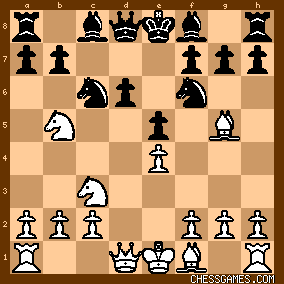
click for larger view8... a6
"The Kishinyov master Chebaneko used to uphold 7...Be6?! with the idea of 8. Na3?! d5! along the lines of the 1st game of the Fischer Petrosian match...but here 8. Nd5! and c3 is stronger." (Kasparov). This line appeared in the famous game between Tarrasch and Janowski at Vienna 1898. Tarrasch continued 9. BxN. Didier, however, found a much better move. The position after 8...a6 was:

click for larger view9. Na3
"!"--(Kasparov)
"Better than 8. [9.] BxN." (Kasparov)
This move in fact was first played in Sellman-Bird, London 1883. It is now the critical line in the Chelyabinksk Variation. 
click for larger view9... Be7
"?!"--(Kasparov)
"Janowski's move is insufficient on account of 9. c4! (Averbakh-Korchnoi, Tula 1950). Kasparov recommends the modern move: 9 [8]...b5. Fritz and Stockfish both prefer 9...Be6, the move played by Bird in the 1883 game that introduced the line. The position after Janowski's 9...Be7 was:

click for larger view10. BxN
Averbakh's 10. Nc4 ["!"--Kasparov] is better, but the two games quickly converged. 10... BxB
"10...gxB might be suggested. After the text move White gains time with Nc4 attacking the d-pawn and from this point the complications arose." (Tournament Book). 10...gxB looks rotten. Black still has a quite playable game with the text without the problems created by messing up his pawn structure. The position after 10...BxB was:

click for larger view |
|
Oct-06-19
 | | KEG: Post II
11. Nc4!
The backward d-pawn is Black's weakness here. Didier could have played this on his last move, but makes up for lost time here. On any reckoning, White is better. 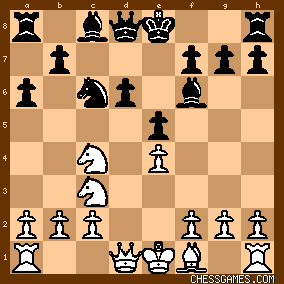
click for larger view11... Nd4?!
With this move, the game transposes to the 1950 Averbakh-Korchnoi game. Janowski had played this position two years earlier in an 1899 exhibition game against Koehler. There he played 11...Be7, the move Fritz 15 prefers and which looks best to me. Stockfish disagrees with all of this and plays 11...Be6?!, prepared to sacrifice a pawn and trade Queens to obtain counterplay. 12. Nd5!
The move Averbakh played against Korchnoi. It exploits the hole on d5 and creates a crisis for Black. 
click for larger view12... b5
Korchnoi's move as well. It is obviously risky and leaves new holes in Black's position. Thus, both Fritz and Stockfish prefer 12...Rb8. But I'm with Janowski and Korchnoi on this one. Better to try drastic counterplay than suffer placidly in an inferior position. Having played the ultra-aggressive (and questionable) 12...Nd4?!, the text seems the logical follow-up. 13. Ncb6
Much stronger than 13. c3.
13... Rb8
What else?
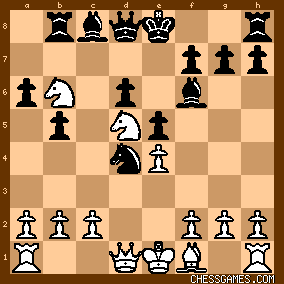
click for larger viewThus far, Didier had played excellent creative chess and had the better game. But now he began to go astray. 14. c3
14. NxB as played by Averbakh against Korchnoi is simplest and stronger. The move would have been especially useful against Janowski, who was--as he would prove once again in this game--a terror when wielding the two Bishops. After 14. c3, the key position of the game had been reached: 
click for larger view14... RxN!
"The sacrifice of the exchange is too bold, using a mild term." (Tournament Book) The Tournament Book recommended instead 14...Ne6. This would have yielded a vastly inferior game for Black after 15. NxB QxN 16. a4 0-0 17. axb5 axb5 18. Be2 I prefer Janowski's move (by a mile). So do Fritz and Stockfish. Ten years ago, MaxxLange on this site reported that Rybka thought 14...RxN was forced but that Black's position was bad. I disagree with the evaluation. Janowski got major counterplay with this sacrifice, and his Bishops quickly controlled much of the board while Didier's Rooks were still at home. White is certainly theoretically better after the sacrifice, but over the board Black has fine chances. I would bet that Janowski was not unhappy at this point. 15. NxR
Much better than 15. cxN
15... QxN
16. cxN
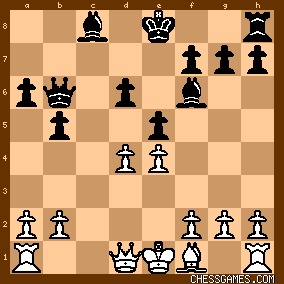
click for larger viewIf I were White playing Janowski here, I would be very worried. I would know that I enjoyed some sort of advantage, but I would look at Janowski's Bishops and be very worried. |
|
Oct-06-19
 | | KEG: Post III
16... exd4?
Surprisingly, Janowski missed the very strong 16...d5! giving him all sorts of tactical counter-chances. 16...0-0 would also have been better than the text. To justify his sacrifice, Black needs to activate his forces quickly. The text could have caused problems for Janowski. 17. Bd3
17. a4 was perhaps even better.
17... 0-0
I am also surprised that Janowski didn't hustle to get his White-square Bishop into play with 17...Bd7. 18. 0-0 Be6
18...Bd7 was better. After the text, the position was: 
click for larger view19. b3
The Tournament Book incredibly states that Didier had a win here with 19. Rc1: "19. Rc1 would have won the game. Black could not capture the a-pawn because 20. b3 would have imprisoned the Bishop. Occupying the open file would have forestalled Black's Rc8, powerful move after Rc3." 19. Rc1 would certainly have been better than the text and would have precluded the upcoming play by Janowski on the c-file. But to claim a win with the move seems ridiculous. After 19. Rc1 Rb8 20. a4 bxa4 21 Qxa4 a5 White would indeed be better but the game would have been far from over (and with Janowski still holding the two Bishops my money would have been on him and not Didier). 19. a4 was also much better than the text.
I agree, however, that 19. b3 was a turning point in the game after which Janowski began to take over the board from his over-matched opponent. 19... Rc8!
?!?--Tournament Book.

click for larger view20. Kh1
In preparation for 21. f4. But this is all too slow. 20. a4 was more dynamic and best. 20... Rc3!
"!"--(Tournament Book).

click for larger viewWhat a difference from the position before 19. b3. The game is now double-edged, and it's hard to tell who is better. Both Fritz and Stockfish (unhelpfully) rate the position as 0.00. My book on Alpha-Zero mocks Stockfish for its 0.00 evaluations in complex positions. If I had to pick a side to play, I would pick Black in a nano-second. 21. f4!
A sign that Didier was not prepared to go down without a fight. 21... h6
21...Bd7 getting the Bishop into the fray was an interesting alternative. 22. Qe2 Qc5
Preventing Rc1 by White.
23. h3
Didier might have considered 23. Rad1.
23... Bd7
24. Rf3

click for larger view |
|
Oct-08-19
 | | KEG: Post IV
Who was better at this point? White is up the exchange. Black has two powerful Bishops and substantial pressure. A very interesting and tough position. 24... Qh4
"Threatening Bg4, Bkack's handling of the position after having established Rc3 is highly interesting and instructive. Still, in spite of all his ingenuity, he should not have won the game." (Tournament Book) 25. Kg1 a5

click for larger viewFrom this position, a new problem arises: it is unclear what was played on moves 26 and 27. The Tournament Book gives the score here as: 26. Raf1 Bc6
27. g4 Qc5
This site inverts the move order:
26. g4 Qc5
27. Raf1 Bc6
Neither order looks right. If Didier played 26. Raf1, 26...Qc5 was not best (26...Bc6 would have been better). On the other hand, the order appearing in this site males 27...Bc6 hard to explain (27...Bh4 would be better. The Tournament Book seems clearly correct that 26. e5 [rather than 26. Raf1 or 26. g4] was a good alternative. One thing does seem clear, after 27 moves the position was: 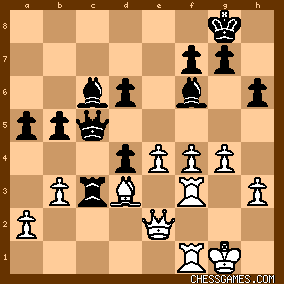
click for larger viewBlack looks somewhat better here than two moves earlier, but the game was still very much up for grabs. 28. Qe1
"To support the advance of the h-pawn. But he has no time for it, as Janowski speedily shows." (Tournament Book). Although hardly a fatal blunder, this move was the beginning of Didier's downfall. He should have played 28. Qf2. 28... b4!
A true Janowski move. He certainly knew how to use his Bishops, and the text made b5 available for his c6 Bishop. 29. h4
Consistent with his 28th move but not good. 29. Qe2, 29. Qd1, and even 29. Kg2 were all better. 29... Bb5!

click for larger view30. Qg3?
"30. BxB would have been comparatively better." (Tournament Book). Agreed.
30... BxB
31. RxB Bxh4!
Didier apparently overlooked this intermediate move. The game was now probably beyond salvage for White. After a few more second-best moves, the word "probably" can be deleted from this evaluation. The position after 31...Bxh4! was as follows:

click for larger view |
|
Oct-08-19
 | | KEG: Post V
32. Qh3
If 32. RxR then obviously 32...dxR+ wins the Queen." (Tournament Book). 32... Bf6

click for larger view33. Rf2
Didier should at least have gotten his King off the nasty diagonal with 33. Kg2 or 33. Kh1 rather than tie up his Rook as a shield. 33... Qb5
34. Rfd2 Qc6
Janowski could have played g5 here rather than wait a move to make this powerful thrust. 35. Qf3
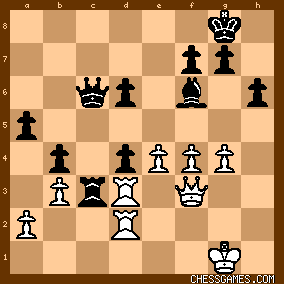
click for larger view35... g5!
36. fxg5?
This only eased Janowski's task, but Didier was in trouble anyway. 36... Bxg5
37. Rf2 Qd7

click for larger view38. RxR?
Now the game becomes a massacre. Didier should have played 38. Re2. In fairness to Didier, however, by this point there was almost certainly no way to save the game. 39... bxR
39. Rc2 Qb5
Janowski could also have just played 39...Be3+.
40. Qf1
Didier was seemingly just going through the motions at this point. 40. Rf2 (or perhaps 40. Kg2) was the best way at least to prolong the game. 40... Qe5
40...Be3+ would have been faster.
41. Qf3 Be3+
42. Kf1

click for larger view42... Qg5
42...Qb5+ was faster, but Janowski seems to have been enjoying himself too much to finish off the game quite yet. This sort of playing around might have cost Janowski dearly had he been playing someone like Lasker. But the opponent here was Didier, and Janowski might have felt he could win any way he pleased. 43. Kg2
43. Qf5 would have offered sterner resistance.
43... Qe5
Hard to understand why Janowski didn't play 43...h5. But then again, he may have wanted to enjoy his crushing position a little longer. 44. Re2 Kg7
Still playing around. 44...Qc5 was obviously faster. After 44...Kg7 the position was:

click for larger view45. Re1??
Immediately disastrous, but maybe Didier wanted to end the misery. 45... c2
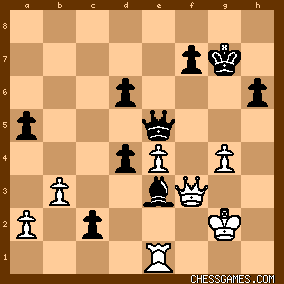
click for larger viewOuch!
0-1 |
|
|
|
|





